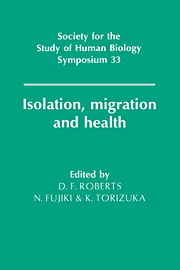Book contents
- Frontmatter
- Contents
- List of contributors
- Preface
- 1 The legacy of the IBP: Presidential Address
- 2 The distinction between primary and secondary isolates
- 3 Time trends in the break-up of isolates
- 4 Factors influencing the frequency of consanguineous marriages in Japan
- 5 Break-up of isolates
- 6 Isolates in India: their origin and characterisation
- 7 Consanguineous marriages and their genetical consequences in some Indian populations
- 8 Biomedical and immunogenetic variation in isolated populations in India
- 9 Genetic distance analyses in Israeli groups using classical markers and DNA polymorphisms in the β globin gene
- 10 Non-random distribution of Gm haplotypes in northern Siberia
- 11 Allele frequency estimation
- 12 Genetic affinities of human populations
- 13 Inherited neurological diseases in island isolates in southern Japan
- 14 Serological and virological evidence for human T-lymphotropic virus type I infection among the isolated Hagahai of Papua New Guinea
- 15 Analysis of genes associated with hypercholesterolaemia in the Japanese population
- 16 Migrant studies and their problems
- 17 Tokelau: migration and health in a small Polynesian society - a longitudinal study
- 18 Micromigrations of isolated Tuareg tribes of the Sahara Desert
- 19 Population structure in the eastern Adriatic: the influence of historical processes, migration patterns, isolation and ecological pressures, and their interaction
- 20 Diabetes and diabetic macroangiopathy in Japanese-Americans
- 21 Diabetes and westernisation in Japanese migrants
- 22 Environmental factors affecting ischemic heart disease
- Epilogue
- Index
19 - Population structure in the eastern Adriatic: the influence of historical processes, migration patterns, isolation and ecological pressures, and their interaction
Published online by Cambridge University Press: 05 March 2012
- Frontmatter
- Contents
- List of contributors
- Preface
- 1 The legacy of the IBP: Presidential Address
- 2 The distinction between primary and secondary isolates
- 3 Time trends in the break-up of isolates
- 4 Factors influencing the frequency of consanguineous marriages in Japan
- 5 Break-up of isolates
- 6 Isolates in India: their origin and characterisation
- 7 Consanguineous marriages and their genetical consequences in some Indian populations
- 8 Biomedical and immunogenetic variation in isolated populations in India
- 9 Genetic distance analyses in Israeli groups using classical markers and DNA polymorphisms in the β globin gene
- 10 Non-random distribution of Gm haplotypes in northern Siberia
- 11 Allele frequency estimation
- 12 Genetic affinities of human populations
- 13 Inherited neurological diseases in island isolates in southern Japan
- 14 Serological and virological evidence for human T-lymphotropic virus type I infection among the isolated Hagahai of Papua New Guinea
- 15 Analysis of genes associated with hypercholesterolaemia in the Japanese population
- 16 Migrant studies and their problems
- 17 Tokelau: migration and health in a small Polynesian society - a longitudinal study
- 18 Micromigrations of isolated Tuareg tribes of the Sahara Desert
- 19 Population structure in the eastern Adriatic: the influence of historical processes, migration patterns, isolation and ecological pressures, and their interaction
- 20 Diabetes and diabetic macroangiopathy in Japanese-Americans
- 21 Diabetes and westernisation in Japanese migrants
- 22 Environmental factors affecting ischemic heart disease
- Epilogue
- Index
Summary
Introduction
In the last few decades population structure of human groups has emerged as posing some of the most interesting and provocative problems in contemporary anthropological and genetic sciences. Migration is a principal feature acting directly (though with varying intensity) on both genetic equilibrium and demography of populations, so that migration analysis is essential for the understanding of population structure at all levels (Roberts, 1988). Few human populations today remain isolated; those that are not, experience different migratory pressures. At the global level, international migration today is a major topic of economic and social concern (Appleyard, 1988), while the biological effects of human migration are of considerable importance to a wide variety of disciplines (Mascie-Taylor & Lasker, 1989) including anthropology, demography, epidemiology and genetics. A few years ago, discussing the importance of genetic structure in human microevolution, Roberts (1987) noted ‘Every human population can be regarded as a continuing entity occupying a particular space. … A population can be characterised statistically, and distinguished from other populations, by the use of parameters, its group attributes (e.g. birth rates and death rates, means and variance of metric characters, territorial density, gene frequency) which are meaningless relative to any individual. The population is permanent in relation to the individuals composing it; for the individual is born into the population, which exists before his arrival and continues to exist after his death.’ This chapter presents an analysis of the results from studies of the population structure of contemporary European rural communities in the Eastern Adriatic.
- Type
- Chapter
- Information
- Isolation, Migration and Health , pp. 204 - 218Publisher: Cambridge University PressPrint publication year: 1992
- 13
- Cited by

